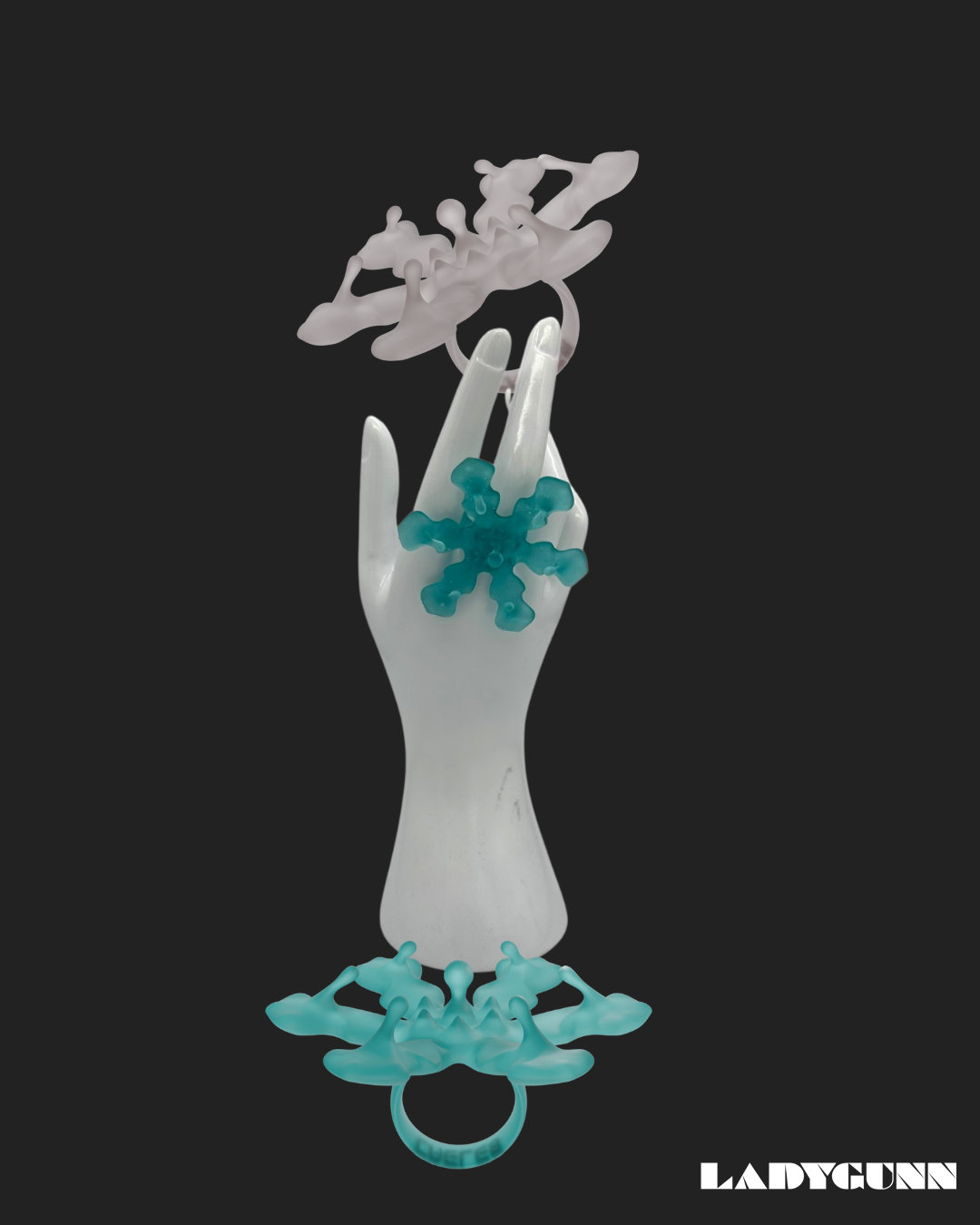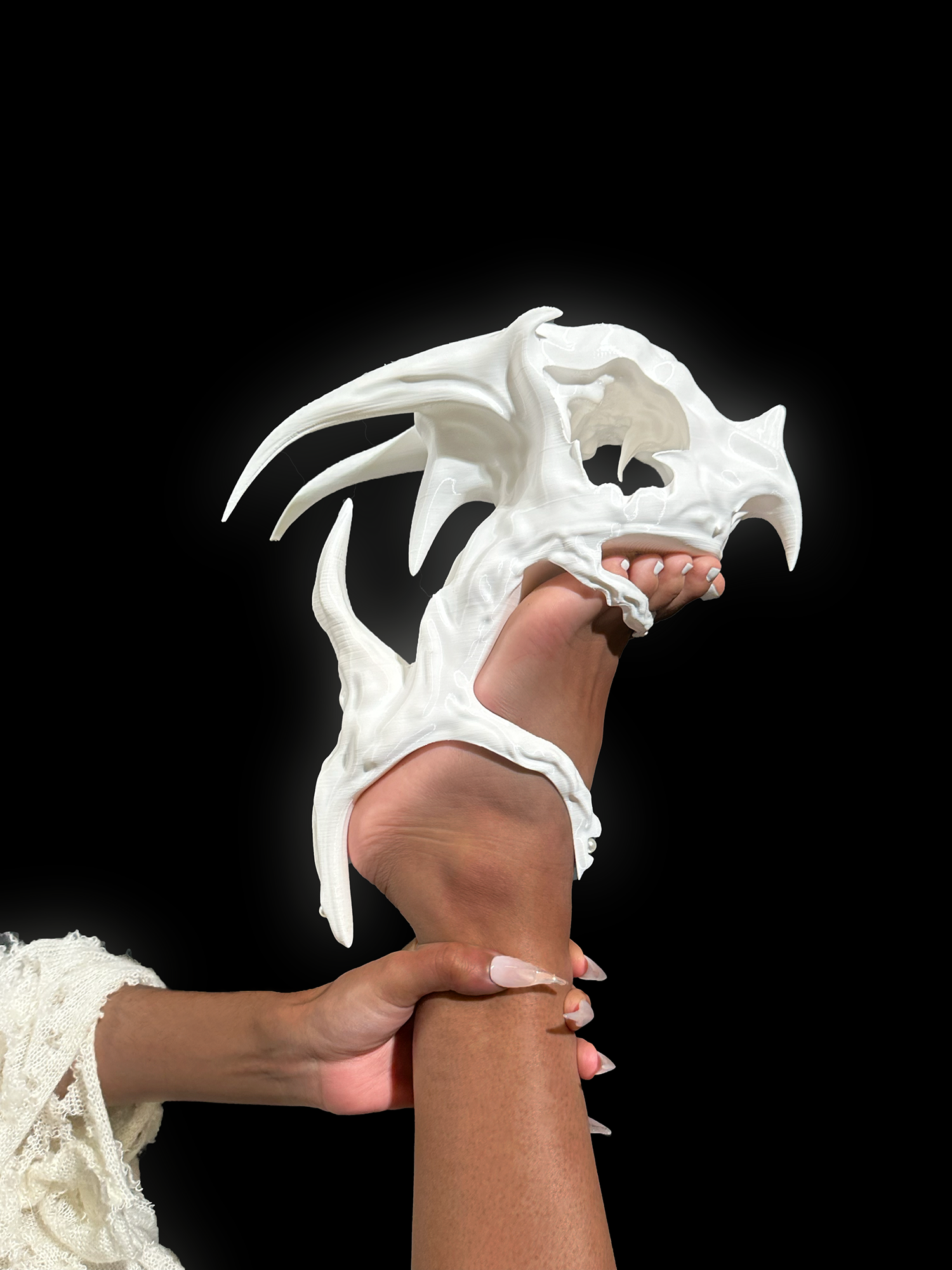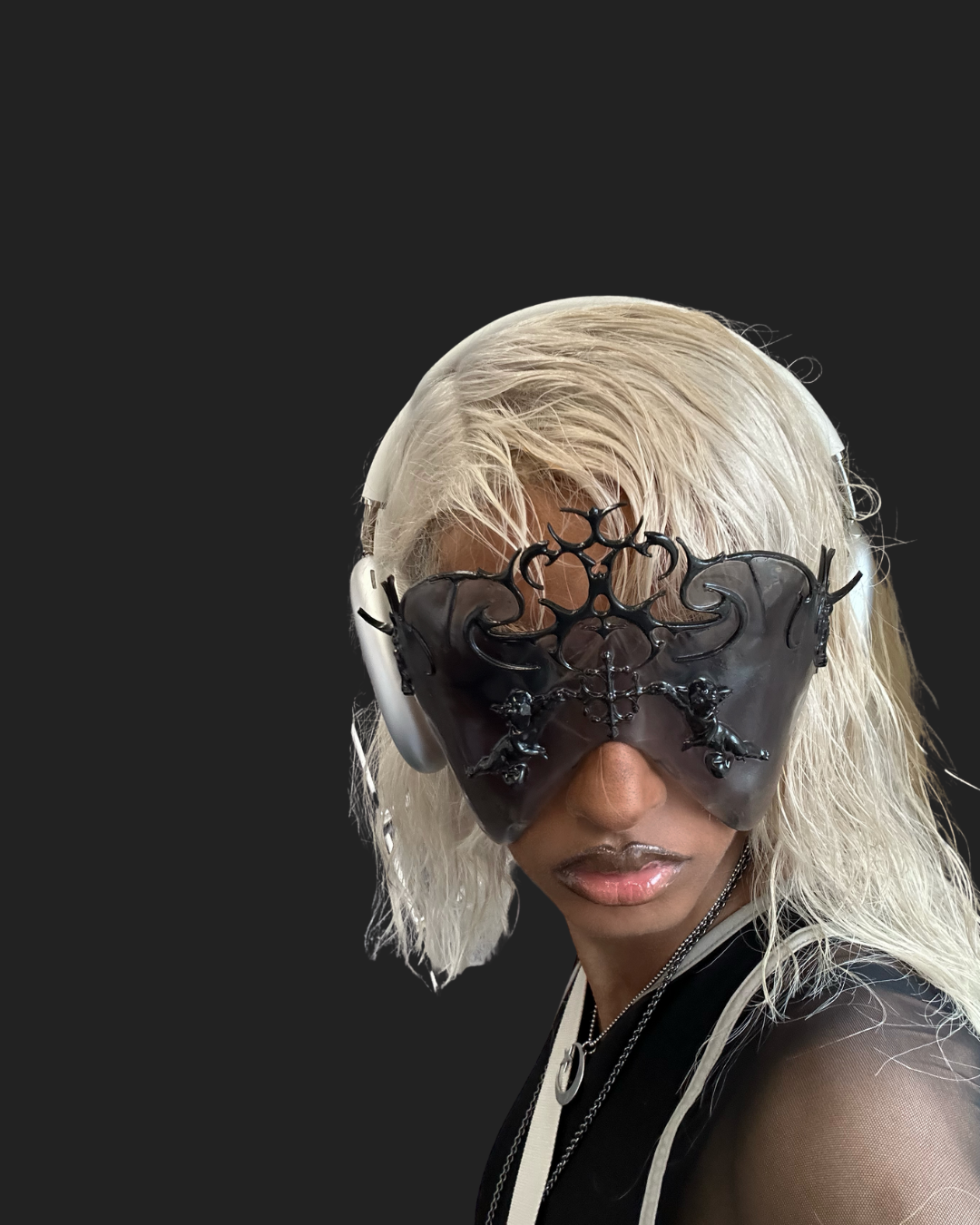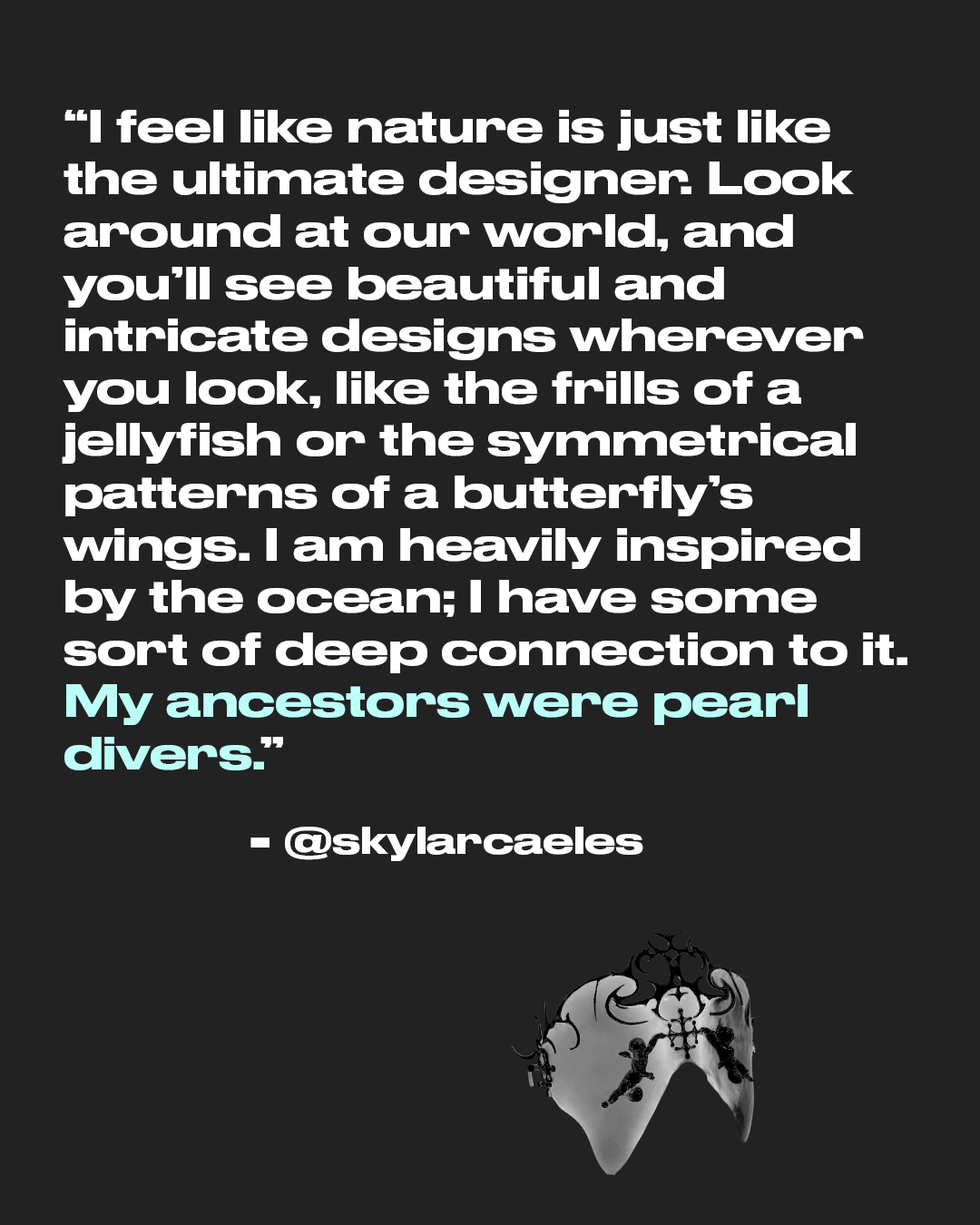Skylar Caeles is a visionary New York–based artist transforming fashion and performance through innovative wearable art. Combining digital design, 3D printing, and couture craftsmanship, she creates pieces that command global stages—from Beyoncé’s tours to Coachella sets and the Tony Awards. Her work also intersects theater and fashion, including New York Fashion Week showcases and the upcoming revival of The Phantom of the Opera.
Alongside her collaborative achievements, Skylar Caeles has cultivated her own practice through her studio CAELES, producing wearable objects and accessories that blend conceptual rigor with striking visual design. From her widely shared 3D-printed Ripple Shades to her sold-out Snowflake rings, her work has captured the attention of global fashion platforms such as Highsnobiety and AVNT and even earned admiration from cultural icons like Erykah Badu and Bree Runway. In this interview, we speak with Skylar about her inspirations, process, and the evolving dialogue between technology, fashion, and art that drives her practice forward.
Your work blends digital fabrication (like 3D modeling and printing) with couture-level craftsmanship. What inspired you to combine these two worlds, and how do you navigate the tension and synergy between precision and hand-finished detail?
I think these two worlds are closer to each other than most people realize. A lot of the couture-level conceptualization starts out in a digital field before it translates to real life. When I think of something I want to make, I imagine it in my head before I make it a reality, and that’s exactly what 3D printing does; maybe that’s why I think computers and human brains work similarly. There are parallels in the way they’re structured. They’re not identical, but they share similar choreography. The digital realm, subconscious realm, things you imagine in your head, images you generate on your computer. Neurons in the brain fire transmitters through synapses. In a computer, chips, RAM, and GPU move electricity through circuits and memory. Taking intangible ideas/visuals from your brain/computer screen and materializing them into real life. Machines are perfect at repetition; hands are perfect at decisions; human craftsmanship has always been about the improvement of both precision and hand-finished detail. I use 3D modeling programs like Blender and Nomadsculpt to form the first shapes, like a potter would form clay with their hands, until data becomes matter.
At CHRISHABANA, you’ve contributed to custom pieces worn by Beyoncé, Missy Elliott, and Harry Lennix. Can you talk about how these collaborations started and what it’s like seeing your designs on such high-profile figures? Did it shift your approach or creative confidence?
I was a stylist intern for Lee Christmas, running drop-offs, and one of them was Chris Habana. Lee is so nice and is such a great stylist. She saw my potential and put me in touch with Chris, which is something that I’m grateful for to this day. I’ve been on the team ever since. Missy Elliott was the first celebrity project Chris had me work on, and already I was like, “Whoa, are you sure? Like, I just got here,” but pretty soon I realized that dealing with A-listers was just a regular thing for Chris and the studio. Being an immigrant from another continent, getting to work on projects for such prominent celebrities was as if I were stepping into a fantasy world. It felt like a wall got lifted between me and all these larger-than-life people that you only ever see in the most prestigious and glamorous settings. It still seems surreal that I’m now able to help create these settings instead of just enjoying them from the sidelines. The very next project after Missy Elliott was Beyoncé, and I thought to myself, “I can’t believe Chris has this much faith in me, like we’re talking about one of the most legendary people in the history of music.” I quickly realised I had to strap up my metaphorical boots as each project was high stakes, and I had to learn new skills on the spot when needed. I experienced that fresh-off-the-boat, wide-eyed kind of starstruck, where the untouchable figures I’d never dreamed of having any sort of connection with suddenly stepped out from the mystical contraptions of stardom, only for me to find myself behind the curtain, helping them assemble the next spectacle for the crowd. I had a lot of imposter syndrome during that time, and I still do to this day! For example, I still can’t believe a brooch I 3D modeled for Harry Lennix at the Tony Awards is now immortalized on Getty Images. It’s made me feel more cognizant about who sees my work and where it may end up. You never really know who’s watching you behind the cloak of anonymity on the internet. Regardless, my creative system is selectively permeable…more membrane than sponge. Ideas circulate in a closed loop until they stabilize; nothing gets in unless I choose it. If a reference knocks, it has to cross the gate: Does it serve the form? Does it sharpen the feeling? If not, it bounces off.

The Snowflake rings resonated enough to sell out a blue colorway and land a consignment deal at Retail Pharmacy in Manhattan. How did the concept come about, and how did it feel to see a design you created gain that traction so quickly?
hiHonestly, the design for that came on a whim. It initially started as a sort of flower shape, and I was playing around with it a lot, trying to give some form to this amorphous blob on my iPad screen, and I kind of go through this sort of creative hypnosis state where I’m not thinking of what I’m doing, and I’m just designing and creating and letting my hands and eyes move autonomously from my brain. I really liked the shape of the design that I came up with, and to me, it looked more like a snowflake than a flower at that point, so I dubbed it the snowflake rings. It was also winter when I debuted these rings, so it felt fitting at the time. When one of the colorways sold out at Retail Pharmacy, I genuinely couldn’t believe it. I had zero expectations and was honestly worried not even one would sell; when one did, I was ecstatic. It feels good to know people like my designs and find them beautiful enough to wear and worth the price point.

The Houndstooth Heels were your first venture into 3D-printed footwear and one of your proudest creations. What challenges did you overcome in translating biological and skeletal inspiration into wearable form?
Yes, it’s genuinely still one of my proudest creations ever, just because of how much more intensive and precise you have to be to make footwear compared to a ring, for example. These actually have to be functional to walk around in, and they are. Perfect for editorials and controlled wear. I made the design for these relatively quickly; I was in that creative hypnosis state that I talked about earlier, and when I was done, I realized that the shape of these heels kind of resembled that of animal skeletons. Primal and sharp, yet just alien enough to be unable to pinpoint, I tried to create a perfect balance between familiarity and the unknown.
The Angelvision eyewear is conceptually rich, intentionally limiting central vision to amplify peripheral awareness and provoke questions of guidance, trust, and power. Could you unpack what sparked this idea and how users respond when wearing them?
I was born and raised Muslim, and until I moved to America, Islam was central to my life and inescapable. Curiosity was never encouraged in my household, and I was taught that some things simply did not need to be questioned. This constant contact with religion sparked within me a fascination with the concept of angels – these beings of pure light, warmth, and God’s grace, the definition of all that’s good and pure. I wanted to turn this concept on its head. I began to examine how angels in Islam differ from those in Christianity, and how Catholic depictions in particular fascinated me. Catholicism paints these beings as women and children draped in flowing fabrics with wings. I started to wonder how much of our ‘seeing’ is outsourced: to algorithms, feeds, and other people’s framing. Angelvision reverses that: your forward tunnel narrows, and the world floods in from the edges. It’s disorienting at first, then oddly clarifying. You slow down, turn your head, and negotiate space more consciously. The object becomes a social experiment: who leads, who follows, and who do you trust when your default field of vision is disrupted?
As the founder of your own studio, CAELES, what drove your vision for wearable objects and accessories?
When I first discovered 3D printers in the library, I played around with them because students were able to use them for free. I had a realization of “Oh my God, I can literally make anything.” 3D printers truly feel like a step towards the future. The first thing I thought of was jewelry and accessories for myself because I take pride in wearing one-of-a-kind pieces, and if people were to ask me where I got this ring or necklace from, I could be like, “Oh, I made it.”

How do you balance personal expression with market viability, the line between art and commerce?
I honestly don’t think about market viability at all. I make what I like, and so far people have liked it. I pour my ideas and creativity into the accessories I create. Everything I make feels like an extension of myself, and it seems like people want a piece of me. I run two lanes that feed each other: one is editorial/prototype, riskier forms, new materials, and ideas that push behavior. The other is retail, refined silhouettes, durable finishes, and responsible price bands. I use a simple matrix: hours, materials, production method, and the emotional “hit” of the object. Limited editions and smart pricing let people buy in without diluting the design. The Snowflake rings at $95 are a good example: accessible entry that funds deeper experimentation.
You often draw inspiration from nature (snowflakes), anatomy (canine skeletal structures), and spiritual metaphors (cherubs in Angelvision). What attracts you to working with these themes, and how do they shape not just form but storytelling in your objects?
I feel like nature is just like the ultimate designer. Look around at our world, and you’ll see beautiful and intricate designs wherever you look, like the frills of a jellyfish or the symmetrical patterns of a butterfly’s wings. I am heavily inspired by the ocean; I have some sort of deep connection to it. My ancestors were pearl divers. I truly do have some unusual fixation with pearls as well. I’m obsessed with them because they’re the only gem formed from a living creature. They’re universal languages. Water, bones, and myths carry built-in meaning: order and chaos, movement and protection, and guidance and power. I don’t literalize them; I translate them into rules: symmetry that almost breaks, ribs that imply motion, and halos that behave like blinkers. The story is encoded in the geometry, and the wearer completes it. If the piece makes you move or feel differently, it’s doing its job.
With CHRISHABANA’s activation in Masquerade – The Phantom of the Opera revival and your pieces on major tours, what upcoming projects or creative explorations are you most excited about? Are there new materials, techniques, or collaborations on your radar?
There are so many projects in the works and so many projects I’m excited about. I don’t think I should say what they are until they come out, haha. I really want to go to a larger scale with my 3D-printed pieces. I have an idea for a piece of legwear that I want to create, which is still in the works. The designing part is usually the easiest part for me; what takes the most time is pulling the object I designed from the digital realm into the real world. It’s very hard and a steep learning curve, but nothing I haven’t overcome before. I’m ready to continue one-upping myself in the future and can’t wait to see what new avenues I venture into and what new skills I acquire.

CONNECT WITH SKYLAR CAELES
